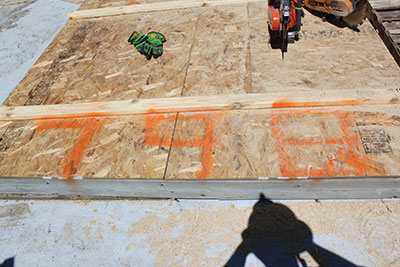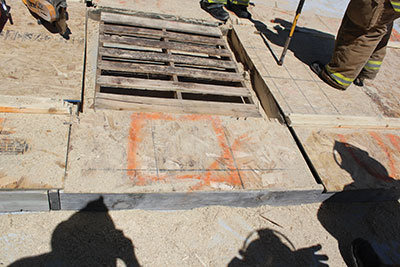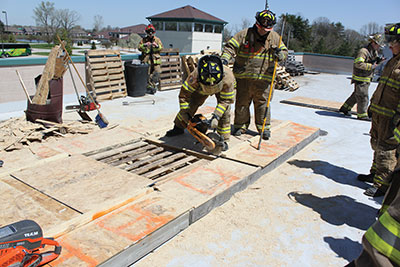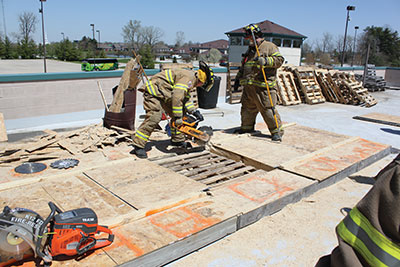
Features
Structural
Training
Back to Basics: March 2014
In February, we explored some aspects of flat-roof ventilation, such as safety considerations and the composition of the roof. Now, we’ll look at two ways to ventilate a flat roof.
February 27, 2014
By Mark van der Feyst
In February, we explored some aspects of flat-roof ventilation, such as safety considerations and the composition of the roof. Now, we’ll look at two ways to ventilate a flat roof.
Depending on the roofing material, use either a rotary saw or a ventilation saw to make the cuts. Determining which saw to use requires some planning. The rotary saw is almost always the best choice because most flat roofs involve some type of metal. Make sure the saw is fuelled, and always bring a set of hand tools with you to help you make the cuts, remove the roofing material, sound the roof deck, and in a worst-case scenario, finish the cut for you. Ideally, bring a flathead axe or a pick head axe and a 1.8-metre (six-foot) roof hook or pike pole.
■ Coffin cut
The coffin cut – also known as the 7-9-8 cut – is one way to ventilate a flat roof. As you can see in photo 1, there are four steps to make this cut; the cuts resemble the numbers 7, 9 and 8.
 |
|
| Photo 1: The coffin cut is also known as the 7-9-8 cut because of the cutting pattern that a firefighter follows during this ventilation operation. Photos by Mark van der Feyst |
The first cut follows the 7 pattern. The firefighter makes two cuts in the shape of the number 7, roughly 1.2 metres (four feet) along the top part of the 7 and about 1.8 to 2.4 metres (six to eight feet) along the spine of the 7. This sets up the coffin cut to be divided into two 1.2-metre by 1.2-metre (four-feet by four-feet) openings, allowing for one large vertical ventilation exit point. The two halves also allow crew members to handle only a small section of the roof – a 1.2-metre by 1.2-metre (four-feet by four-feet) section – at one time, rather than one large section.
The second set of cuts transforms the 7 into a 9 shape by cutting down about 1.2 metres (four feet) from the tip of the 7 and then across to the centre of the spine of the 7. When making these cuts, overlap the corners by about 15.2 centimetres (six inches). This frees the section of roof that is being cut from any obstructions and ensures that it is fully detached from the roof. When the corners are not overlapped, more work is involved to free the cut section.
The third set of cuts is the point at which the 9 becomes the 8. Two more cuts are made down and across to finish the number 8. Once completed, make a diagonal cut in the corner of the 8. This diagonal cut can be made either at the end of the series, at the beginning with the number 7, or at both points in the operation. This diagonal cut creates a small triangular hole, allowing a roof hook or a pike pole to be inserted. This cut will aid as a starting point in pulling up the material.
Pulling up the roofing material takes some effort. Once the material has been removed, do not let it fall inside the building – place it beside the opening.
■ Square cut

|
|
| Photo 2: The square cut involves the firefighter making four straight cuts in the shape of a square and a diagonal line in the corner. Each cut should overlap the previous cut by about 15 centimetres to ensure that the roof is entirely cut through. |
|
 |
|
| Photo 3: There should always be two firefighters performing any roof-top ventilation cuts – the firefighter making the cut focuses on the operation and the second firefighter watches over the conditions, the surrounding area and any other hazards present.
|
|
 |
|
| Photo 4: The firefighter guiding the ventilation operation should never stand in front of the firefighter making the cuts. Doing so breaks the team’s integrity and puts the guiding firefighter directly in the path of flying debris.
|
The square cut is another way to ventilate a flat roof. The square cut is a shortened version of the coffin cut – just five cuts are made in total and the size of the opening can vary. The advantage of the square cut over the coffin cut is that a firefighter making the square cut travels in one direction all the way around the cut. The coffin cut requires a change in direction, providing opportunities for tripping, unsafe footing or even falling into the hole.
The firefighter makes four separate cuts (see photo 2), each overlapping one another by at least 15 centimetres (six inches). The firefighter then finishes the square with a diagonal cut.
There should always be two firefighters making any type of roof cut. The firefighter making the cut focuses on the operation. Another set of eyes are required to guide and watch over the conditions, the surrounding area and any other hazards. It is important that the firefighter making the cut is aware of his partner’s feet and body in relation to the rotary or ventilation saw.
In photo 3, you can see how the firefighter working the rotary saw is being guided by the second firefighter. This is a tandem operation in which the second firefighter is usually behind the first firefighter. The guiding firefighter can get the attention of the cutting firefighter by tapping his shoulder. Notice that the hand of the guiding firefighter is placed on the back/shoulder of the cutting firefighter. This is another way to maintain accountability between the two.
In photo 4, you can see what should not take place: the guiding firefighter is no longer behind or beside the cutting firefighter, but is in front of him. This is a bad position in which to be as the debris from the cut is being thrown into that pathway and because team integrity is now broken. Always make sure the guiding firefighter is beside or behind the cutting firefighter.
Mark van der Feyst is a 15-year veteran of the fire service. He works for the City of Woodstock Fire Department in Ontario. Mark instructs in Canada, the United States and India and is a local-level suppression instructor for the Pennsylvania State Fire Academy and an instructor for the Justice Institute of BC. E-mail Mark at Mark@FireStarTraining.com
Print this page